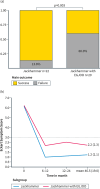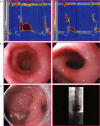Peroral endoscopic myotomy for hypercontractile (Jackhammer) esophagus: A retrospective multicenter series with long-term follow-up
- PMID: 38873948
- PMCID: PMC11497736
- DOI: 10.1002/ueg2.12586
Peroral endoscopic myotomy for hypercontractile (Jackhammer) esophagus: A retrospective multicenter series with long-term follow-up
Abstract
Introduction: Long-term outcome data are limited for non-achalasia esophageal motility disorders treated by peroral endoscopy myotomy (POEM) as a separate group. We investigated a subset of symptomatic patients with hypercontractile esophagus (Jackhammer esophagus).
Methods: Forty two patients (mean age 60.9 years; 57% female, mean Eckardt score 6.2 ± 2.1) treated by primary peroral myotomy for symptomatic Jackhammer esophagus 2012-2018 in seven European centers were retrospectively analyzed; myotomy included the lower esophageal sphincter but did not extend more than 1 cm into the cardia in contrast to POEM for achalasia. Manometry data were re-reviewed by an independent expert. The main outcome was the failure rate defined by retreatment or an Eckardt score >3 after at least two years following POEM.
Results: Despite 100% technical success (mean intervention time 107 ± 48.9 min, mean myotomy length 16.2 ± 3.7 cm), the 2-year success rate was 64.3% in the entire group. In a subgroup analysis, POEM failure rates were significantly different between Jackhammer-patients without (n = 22), and with esophagogastric junction outflow obstruction (EGJOO, n = 20) (13.6% % vs. 60%, p = 0.003) at a follow-up of 46.5 ± 19.0 months. Adverse events occurred in nine cases (21.4%). 14 (33.3%) patients were retreated, two with surgical fundoplication due to reflux. Including retreatments, an improvement in symptom severity was found in 33 (78.6%) at the end of follow-up (Eckardt score ≤3, mean Eckardt change 4.34, p < 0.001). EGJOO (p = 0.01) and frequency of hypercontractile swallows (p = 0.02) were predictors of POEM failure. The development of a pseudodiverticulum was observed in four cases within the subgroup of EGJOO.
Conclusions: Patients with symptomatic Jackhammer without EGJOO benefit from POEM in long-term follow-up. Treatment of Jackhammer with EGJOO, however, remains challenging and probably requires full sphincter myotomy and future studies which should address the pathogenesis of this variant and alternative strategies.
Keywords: Eckardt score; Jackhammer esophagus; adverse events; esophagogastric junction outflow obstruction (EGJOO); failure; lower esophageal sphincter (LES); motility; peroral endoscopic myotomy (POEM).
© 2024 The Author(s). United European Gastroenterology Journal published by Wiley Periodicals LLC on behalf of United European Gastroenterology.
Conflict of interest statement
There were no conflicts of interest for any of the authors in relation to the study topic.
Figures


References
Publication types
MeSH terms
LinkOut - more resources
Full Text Sources

